
 A tornado is best described as a powerful, rotating column of air that reaches from the base of a thunderstorm cloud to the ground. A tornado is best described as a powerful, rotating column of air that reaches from the base of a thunderstorm cloud to the ground.
Thunderstorms form in hot damp air that is approaching a cold front. Some thunderstorms produce strong winds, particularly ones which change direction with height. These are called wind shears.
Horizontal winds that are moving in different directions at different altitudes can form horizontal columns of rotating air. This rotating air gets lifted into the thunderstorm by strong updrafts; as it rises, it stretches and tightens, causing it to spin even faster (like a figure skater who draws in her arms to rotate more quickly).
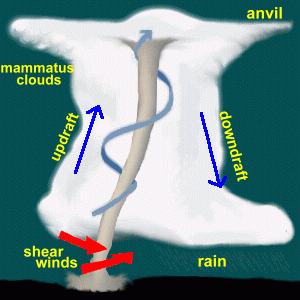
|
|
·The diagram at the left shows a supercell thunderstorm that has generated a tornado. Note the classic thunderstorm shape, and especially the mammatus clouds (shown also in photo below) that are characteristic of tornado-producing storms. Witnesses often describe these clouds as being greenish-blue.
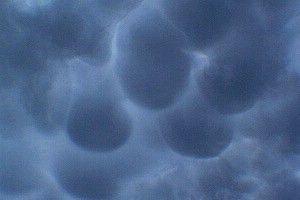
|
A large mass of rotating air is called a mesocyclone, or supercell thunderstorm, and can easily spawn tornadoes. Supercell thunderstorms have strong rotating updrafts with large vertical wind shears. Wind speeds in tornadoes themselves can reach 480 km/h, although only one in every fifty tornadoes have winds greater than about 320 km/h. The large hail that often precedes a tornado forms in the intense updrafts feeding the thunderstorm.
 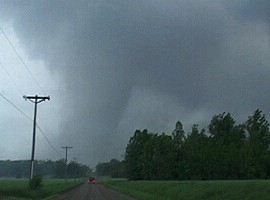
While tornadoes can occur all over the world, they are most frequent in the United States, where some 1,000 tornadoes per year touch down, killing on average 60 people and causing around $850 million in damage nationwide.
Tornado Intensity
The intensity of tornadoes is measured by the Fujita Scale. The scale is divided into levels ranging from F0 to F6, with F6 being the strongest (and rarest) tornado.
The Fujita Scale
| F-Scale Number |
Intensity |
Wind Speed |
Type of Damage Done |
| F0 |
Gale tornado |
65-112 km/h |
Some damage to chimneys; breaks branches off trees; pushes over
shallow-rooted trees; damages signs. |
| F1 |
Moderate tornado |
113-180 km/h |
Peels shingles off roofs; mobile homes pushed off foundations or overturned;
moving autos pushed off roads; attached garages destroyed. |
| F2 |
Significant tornado |
181-252 km/h |
Considerable damage: roofs torn off houses; mobile homes
demolished; boxcars pushed over; large trees snapped or uprooted; light
object missiles generated. |
| F3 |
Severe tornado |
253-332 km/h |
Roof and some walls torn off well constructed houses; trains
overturned; most trees in forests uprooted |
| F4 |
Devastating tornado |
333-418 km/h |
Well-constructed houses leveled; structures with weak foundations
blown off some distance; cars thrown and large missiles generated. |
| F5 |
Incredible tornado |
419-512 km/h |
Strong frame houses lifted off foundations and carried considerable
distances to disintegrate; automobile sized missiles fly through the air
in excess of 100 meters; trees debarked; steel re-enforced concrete
structures badly damaged. |
| F6 |
Inconceivable tornado |
512-610 km/h |
Very rare. Damage these tornadoes might
produce would probably not be recognizable along with the mess produced
by F4 and F5 winds that would surround the F6 wind. |
Note that the Fujita scale measures intensity - the strength of a tornado's winds, not the size of the funnel cloud. Large tornadoes can be weak, while small tornadoes can be strong.
 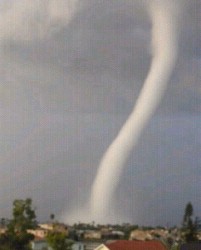 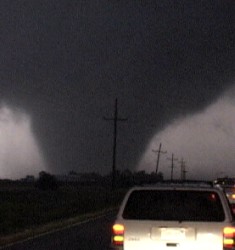
In 1987, an F3-F4 tornado touched down in Edmonton, Alberta, spending over an hour on the ground and causing 27 deaths and $250 million in damages as it worked its way for 40 kilometres across the edge of the city at 35 km/h.
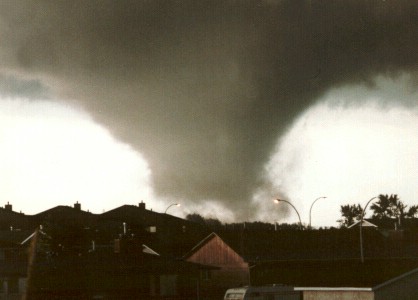 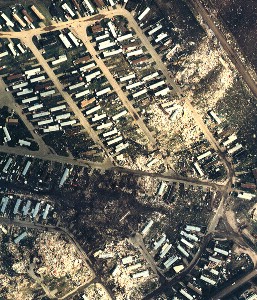
The tornado approaching Edmonton (left) and what was left of the Evergreen trailer park afterward.
Resources
|

 A tornado is best described as a powerful, rotating column of air that reaches from the base of a thunderstorm cloud to the ground.
A tornado is best described as a powerful, rotating column of air that reaches from the base of a thunderstorm cloud to the ground.








